2025年中考英语语法复习-非谓语动词课件(共66张PPT)
文档属性
| 名称 | 2025年中考英语语法复习-非谓语动词课件(共66张PPT) |  | |
| 格式 | pptx | ||
| 文件大小 | 442.8KB | ||
| 资源类型 | 教案 | ||
| 版本资源 | 外研版 | ||
| 科目 | 英语 | ||
| 更新时间 | 2024-07-20 11:32:56 | ||
图片预览


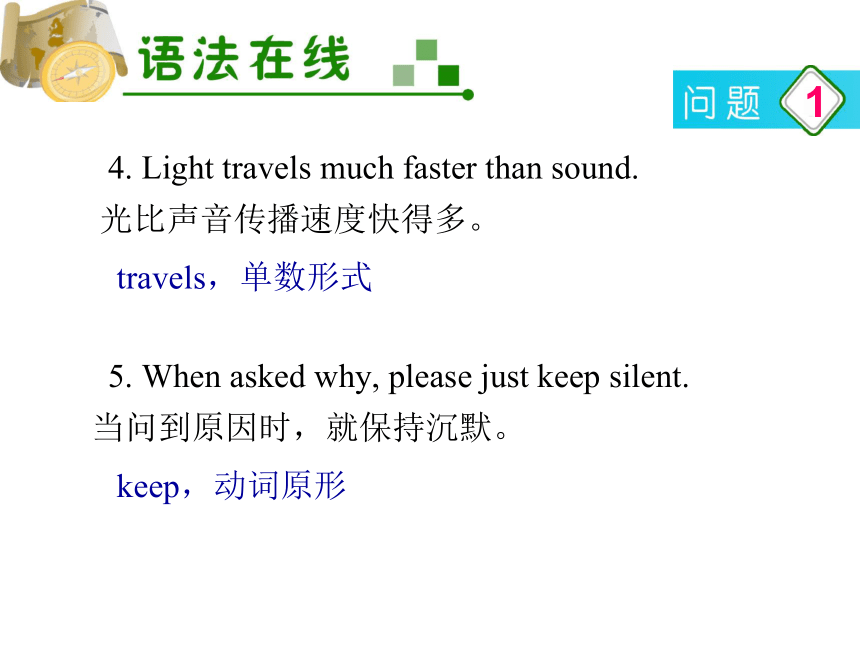
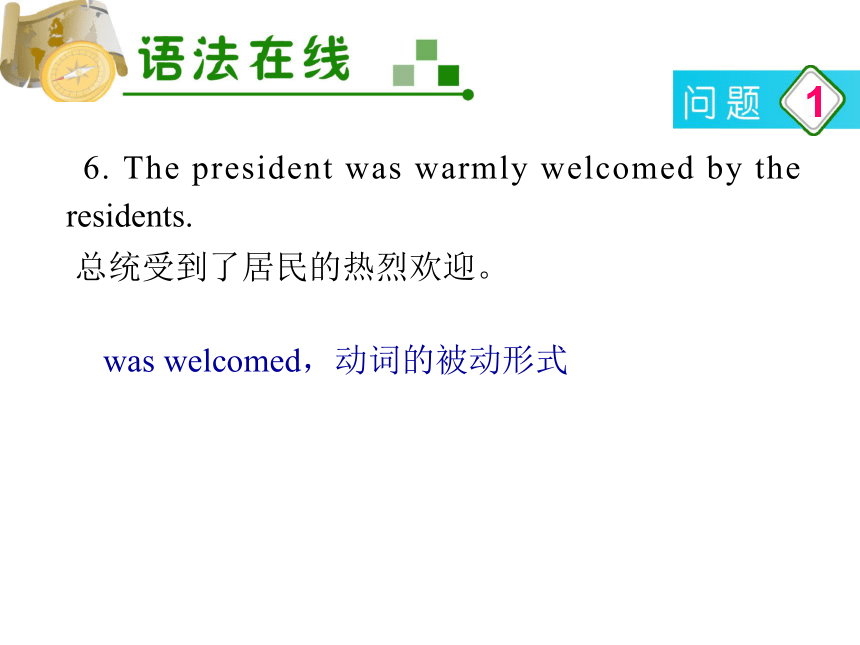

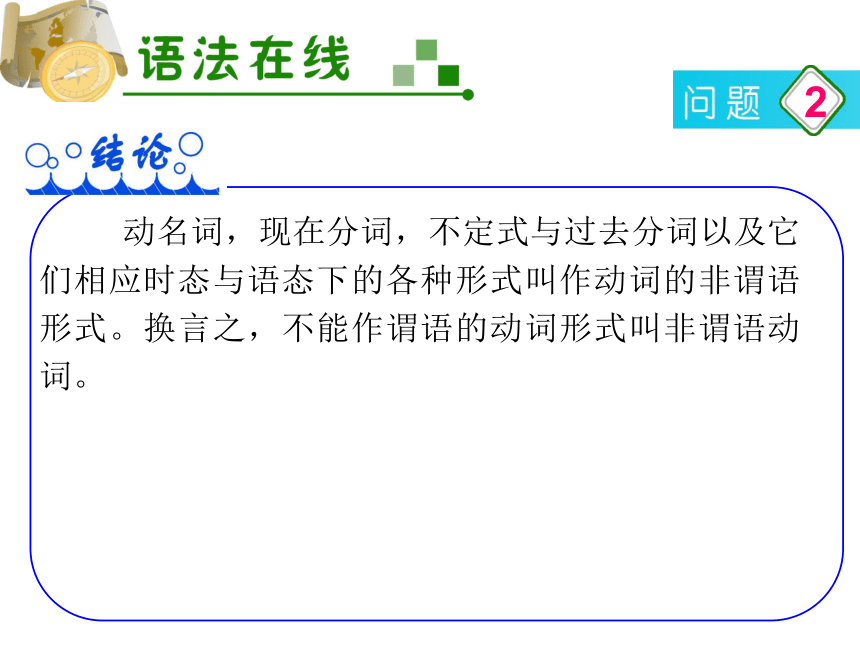
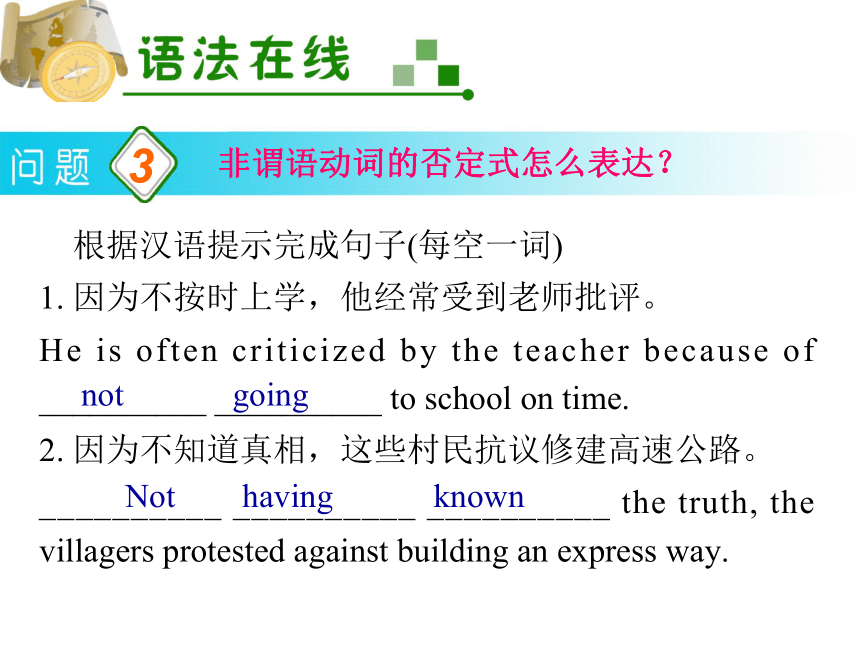
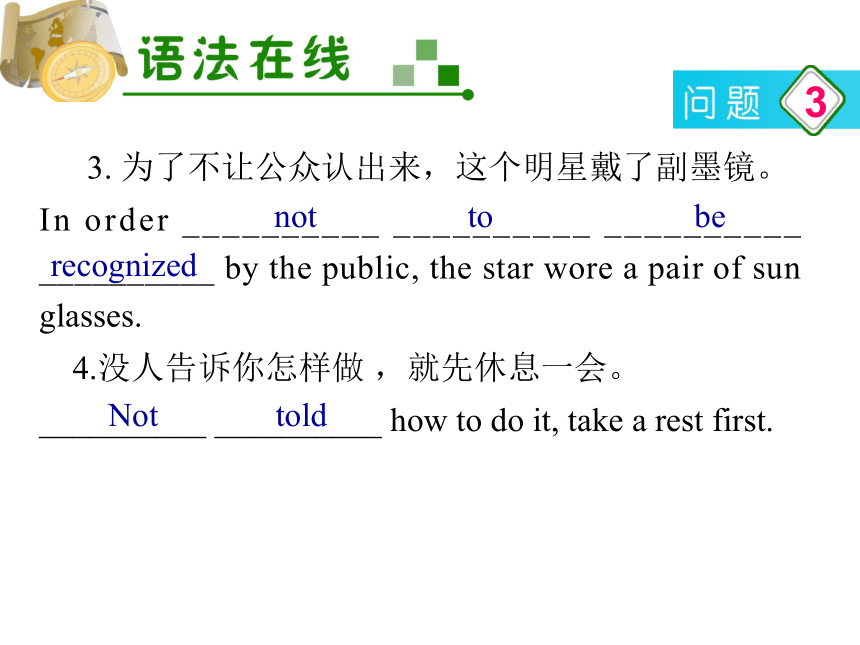

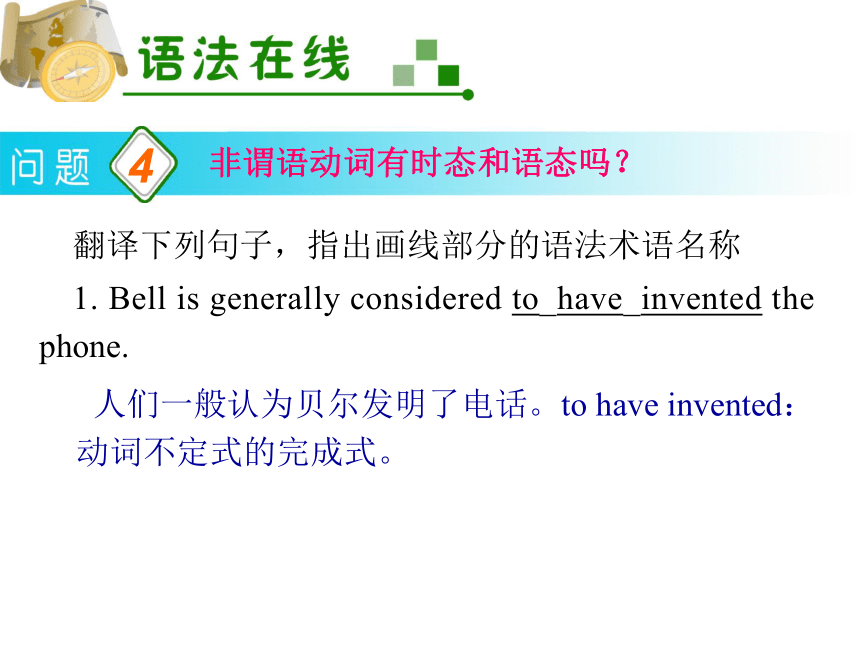
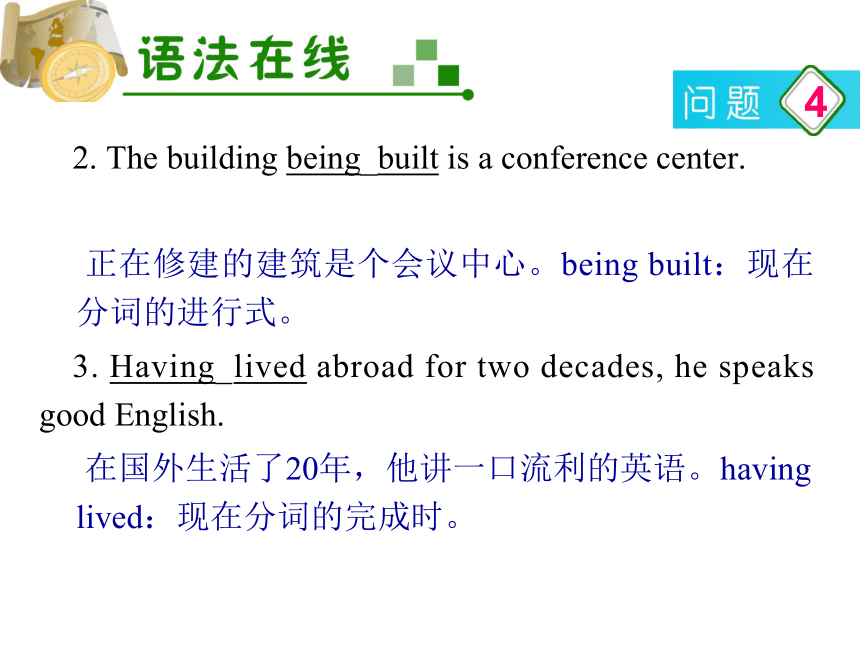
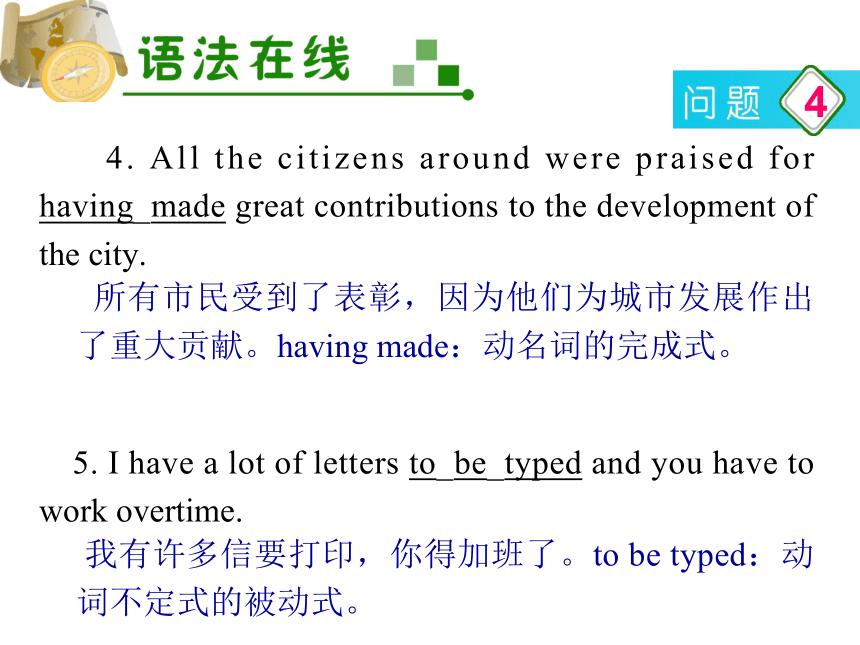
文档简介
(共66张PPT)
找出各句的谓语动词并指出其具体形式
1. Don't teach fish to swim.
不要班门弄斧。
1
哪些是动词的谓语形式?
don't teach,否定式
2. He had a good memory like an elephant.
他以前有很好的记忆力。
3. It would be a waste of money building such a luxurious villa.
建这么豪华的别墅太浪费钱。
1
had,过去式
would be,附加情态动词的动词原形
4. Light travels much faster than sound.
光比声音传播速度快得多。
5. When asked why, please just keep silent.
当问到原因时,就保持沉默。
1
travels,单数形式
keep,动词原形
6. The president was warmly welcomed by the residents.
总统受到了居民的热烈欢迎。
1
was welcomed,动词的被动形式
1
谓语动词的形式包括主动句各种时态下的谓语形式和被动句各种时态下的谓语形式以及情态动词与动词连用的各种形式。
2
动名词,现在分词,不定式与过去分词以及它们相应时态与语态下的各种形式叫作动词的非谓语形式。换言之,不能作谓语的动词形式叫非谓语动词。
根据汉语提示完成句子(每空一词)
1. 因为不按时上学,他经常受到老师批评。
He is often criticized by the teacher because of __________ __________ to school on time.
2. 因为不知道真相,这些村民抗议修建高速公路。
__________ __________ __________ the truth, the villagers protested against building an express way.
3
非谓语动词的否定式怎么表达?
not going
Not having known
3. 为了不让公众认出来,这个明星戴了副墨镜。
In order __________ __________ __________ __________ by the public, the star wore a pair of sun glasses.
4.没人告诉你怎样做 ,就先休息一会。
__________ __________ how to do it, take a rest first.
3
not to be
recognized
Not told
3
非谓语动词的否定式为“ not + 非谓语动词”。
4
非谓语动词有时态和语态吗?
翻译下列句子,指出画线部分的语法术语名称
1. Bell is generally considered to_have_invented the phone.
人们一般认为贝尔发明了电话。to have invented:动词不定式的完成式。
4
2. The building being_built is a conference center.
3. Having_lived abroad for two decades, he speaks good English.
正在修建的建筑是个会议中心。being built:现在分词的进行式。
在国外生活了20年,他讲一口流利的英语。having lived:现在分词的完成时。
4
4. All the citizens around were praised for having_made great contributions to the development of the city.
5. I have a lot of letters to_be_typed and you have to work overtime.
所有市民受到了表彰,因为他们为城市发展作出了重大贡献。having made:动名词的完成式。
我有许多信要打印,你得加班了。to be typed:动词不定式的被动式。
4
6. His_having_been_given help all the time encourages him to be brave enough to face the difficulties.
一直得到别人的帮助,这让他有了面对困难的足够勇气。his having been given:动名词完成式的被动式的复合结构。
4
非谓语动词不仅有时态,而且有语态,具体形式见下表
语态 时 态 主 动
不定式 动名词 现在分词 过去分词
一般 to do doing doing
4
非谓语动词不仅有时态,而且有语态,具体形式见下表
语态 时 态 被 动
不定式 动名词 现在分词 过去分词
一般 to be done being done being done
4
语态 时 态 主 动
不定式 动名词 现在分词 过去分词
完成 to have done having done having done
进行 to be doing
4
语态 时 态 被 动
不定式 动名词 现在分词 过去分词
完成 to have been done having been done having been done
进行 to be being done
4
语态 时 态 主 动
不定式 动名词 现在分词 过去分词
否定式 not +非谓语动词(含各种时态
注意:过去分词无所谓主动和被动式,有且只有一般式done
4
语态 时 态 被 动
不定式 动名词 现在分词 过去分词
否定式 not +非谓语动词(含各种时态
注意:过去分词无所谓主动和被动式,有且只有一般式done
5
动名词,现在分词,动词不定式及过去分词在句中作什么成分?
翻译下列句子并指出非谓语动词在句中充当的成分
1. The HR manager hurried to the airport only to be told the plane had taken off.
那位人事经理急匆匆赶到机场想不到被告知飞机已经起飞。to be told作结果状语。
5
2. Talking to such a man is just like talking to a wall.
3. He came running.
与这样的人谈话等于对牛弹琴。第一个“talking”短语作主语;后一个talking短语作宾语。
他跑着来了。running作方式状语。
5
4. Taken as a whole, the 16th Asian Games are well organized.
整体来看,第十六届亚运会组织得很好。taken作条件状语。
5
非谓语动词动名词,现在分词,动词不定式及过去分词在句中可充当除谓语以外的各种成分,具体用法见下表(一般情况下)
主语 谓语 宾语 定语 状语 补语 表语 独立
成分
动名词 √ × √ √ × × √ ×
5
主语 谓语 宾语 定语 状语 补语 表语 独立
成分
现在 分词 × × × √ √ √ √ √
不定式 √ × √ √ √ √ √ √
过去 分词 × × × √ √ √ √ √
翻译下列句子,指出 ing形式的不同含义并判断其类别
1. Let the sleeping dog lie.
6
现在分词和动名词作定语有何区别?
不要自找麻烦(让正在睡觉的狗躺着)。the sleeping dog 中dog与sleeping有逻辑上的主谓关系,即“狗睡觉”(The dog is sleeping)。sleeping 是现在分词。
2. A sleeping car is expensive.
6
卧车是很昂贵的。a sleeping car中sleeping表示car的用途,即“用来睡觉的车”(a car for sleeping)。sleeping是动名词。
6
动名词和现在分词均可作定语,动名词作定语时,动名词表达被修饰词的用途。现在分词作定语时表达被修饰词与该分词逻辑上的主谓关系。
翻译下列句子,指出 ing形式的不同含义并判断其类别
1. My job is teaching.
7
现在分词和动名词作表语有何区别?
我的职业是教书。teaching与my job是等同关系,teaching表达my job的具体内容。表语teaching和主语my job可交换位置,即可表达为:Teaching is my job. teaching是动名词。
2. My job is interesting.
7
我的职业很有趣。interesting与my job是修饰与被修饰关系,interesting表达my job的特征,性质。表语interesting和主语my job不可交换位置。interesting是现在分词。
7
动名词作表语表达主语的具体内容,此时表语与主语可交换位置。现在分词作表语表达主语的性质与特征,一般情况不可与主语交换位置。
翻译下列句子,指出句中画线部分充当的成分及其含义
1. The old lady hurried to the bus station to see her son off only to_be_told_the_bus_had_left.
8
现在分词和不定式作结果状语有何区别?
老太太匆匆赶到车站给儿子送行,想不到被告知车已开走。不定式短语to be told the bus had left作结果状语,表达出人意料或不情愿看到的结果。
2. We reached the top of the mountain, breathing_hard.
我们到达了山顶,上气不接下气。分词短语breathing hard作结果状语,表达合乎情理的自然的结果。
8
8
不定式(短语)作结果状语时,前面往往有only/just修饰,表达出人意料或不情愿看到的结果;现在分词(短语)作结果状语,表达合乎情理的自然的结果。
翻译下列句子,并指出复合结构在句中充当的成分
1. It was very cruel of_them_to_eat_rare_wild_animals.
2. I don't think it advisable for_him_to_learn_medicine.
3. This is for_you_to_decide.
4. The article is too difficult for_a_child_of_ten_to_
understand.
9
什么是不定式和动名词的复合结构?
5. The order for_them_to_climb_the_mountain was given.
6. John's/John_coming_here will get us out of trouble.
7. I don't remember him/his_giving me that book.
8. I insist on Mary's_going_there.
9. What is most important is Tom's_going_there at once.
9
什么是不定式和动名词的复合结构?
【点拨】
1.他们吃稀有野生动物真够残忍的。不定式的复合结构作主语。
2.我认为他学医不合适。不定式的复合结构作宾语。
3.这得由你决定。不定式的复合结构作表语。
4.这篇文章太难,是一个10岁的孩子理解不了的。不定式的复合结构作状语。
9
【点拨】
5.让他们登山的命令已经发出。不定式的复合结构作定语。
6.约翰的到来将会使我们脱离困境。动名词复合结构作主语。
7.我不记得他给过我那本书。动名词复合结构作动词宾语。
9
【点拨】
8.我坚持要玛丽到那儿去。动名词复合结构作介词宾语。
9.最主要的问题是Tom得马上去那里。动名词复合结构作表语。
9
9
当不定式和动名词的逻辑主语不是句子主语,且又需要指出来时,就在它们的前面加上逻辑主语,就构成了复合结构,即“逻辑主语+不定式或动名词”。
不定式的复合结构有两种:“for + 名词(或代词宾格)+ 不定式”;“of + 名词(或代词宾格)+ 不定式”。不定式的复合结构在句中可以充当主语、宾语、表语、状语和定语。
9
动名词的逻辑主语在正式文体中用名词的所有格或形容词性物主代词,在口语或非正式文体中用名词普通格或人称代词的宾格。动名词复合结构在句中可以充当主语、动词(短语)宾语、介词宾语和表语。
注意:
1.动名词复合结构作主语时一般用名词所有格或物主代词。
9
2. 在口语或非正式语体中,只要不是作主语,动名词复合结构中的逻辑主语常采用名词通格或人称代词宾格。如:
The doctor does not mind me /my eating a little meat occasionally.
大夫并不反对我偶尔吃一点肉。
3.如果逻辑主语是一个短语或有修饰语, 一般用名词通格或人称代词的宾格的形式。
9
如:
I insist on both of them coming in time.
我坚持要他们两人准时来。
4.无生命的事物名词作逻辑主语时一般采用通格形式。如:
The suggestion of the meeting being put off was not adopted by the chairman.
延期召开会议的建议没有被主席采纳。
10
“动词+宾语+宾补”结构中宾补由哪些非谓语动词充当?
用动词的非谓语形式完成句子,总结各组句子宾补的用法
1. (1) Though he is unwilling to give up his choice, I'll have him__________(do) so.
(2) It's a waste of water having the tap __________(run) while washing clothes.
do
running
(3) Unfortunately, the basketball player had had his leg__________(break) just before the match began.
2. (1) I saw her __________(dance) with her partner when I passed by the dancing room.
(2) The CCTV camera saw the two masked men __________(enter) the bank and __________(run) out with a black bag.
(3) Young people are advised not to reply when they hear their names__________ (call) at night.
10
broken
called
enter
run
dancing
3. (1) If caught __________(steal) in the supermarket, the employee will be severely punished.
(2) When arriving at home, the host found all the drawers __________(make) upside down.
10
stealing
made
4. (1) He was online chatting, leaving his homework __________(unfinish).
(2) The manager went into the meeting room and left his driver __________ (wait) in the car.
(3) The director left his secretary __________(attend) to the matter.
10
unfinished
waiting
to attend
从非谓语动词角度看,英语中动词不定式,现在分词,过去分词都可充当宾补。
10
11
根据提示,用with复合结构完成下列句子
1.有如此多的工作要做,新秘书感到很紧张。
__________ so much work__________ __________, the new secretary felt stressed.
2. 让灯通宵亮着,这个男孩早早睡觉了。
__________ the light__________all night long, the boy went to sleep early.
什么是with复合结构?
With
to
With burning
do
3.所有的书都标注了字母,我们很容易找到要看的书。
__________ all the books __________ with letters, we can find a book easily.
With marked
11
“with+宾语+宾补”结构叫with复合结构,在句中主要作状语,有时可作定语。其结构为:
11
12
翻译下列句子,指出画线部分非谓语动词的用法特点
1. I have much to_do and I can't go shopping with you.
2. Many people have caught a bad cold. The weather is to_blame.
3. The Great Wall is worth visiting another time, I think.
4. With a lot of problems to_settle,_I am as busy as a bee.
非谓语动词的主动表被动用法有哪些?
5. The plant needs watering.
6. The problem is hard to_solve.
7. The man hung around, for there was nothing to_do.
8. Give me a book to_read,_please.
12
【点拨】
1. 我有许多事要做,我不能同你去买东西了。 do与被修饰词much有逻辑上的动宾关系,此处用to do表被动用法。
2. 许多人得了重感冒,都怪这天气。blame与weather 有逻辑上的动宾关系,此处用to blame表被动用法。
3. 我认为长城值得再游览一次。 visit与The Great Wall 有逻辑上的动宾关系,此处用visiting表被动用法。
12
【点拨】
4. 有许多问题要解决,我忙极了。settle与problems有逻辑上的动宾关系,此处用to settle表被动用法。
5. 这棵植物需要浇水了。water与the plant 有逻辑上的动宾关系,此处用watering表被动用法。
6. 这个问题很难解决。solve与problems 有逻辑上的动宾关系,此处用to blame表被动用法。
12
【点拨】
7. 这个人逛来逛去,无事可干。do与nothing有逻辑上的动宾关系,此处用to do表被动用法。
8. 请给我一本书看。read与a book有逻辑上的动宾关系,此处用主动形式to read为主动表被动用法。
12
非谓语动词主动表被动的句型有:
1. 主 + has/ have/had (有) +宾语+to do 须注意此时“do”的动作由主语发出。
2. 主 + be + to blame
3. 主 + be (是) +worth + doing
4. With + 宾语+ to do
12
5. 主 + needs/need/needed (实义动词) +doing
6. 主 + be (是) +形容词+ to do
7. There is nothing to do(There is nothing to be done 意为“毫无办法”)
8. Give/Show/Reach/Pass/Get/… sb./sth.…to do
12
13
动词在接动名词和不定式作宾语方面有何规律?
根据汉语提示,用括号中所给单词的适当形式完成句子
1. 你认识那个练钢琴的女孩吗?
Do you know the girl practicing__________(play) the piano
playing
2. 出门时记得关灯。
Remember__________ (turn) off the lights before you leave.
3. 我喜欢打篮球而我哥哥的爱好是游泳。
I like __________(play) basketball while my elder brother's hobby is swimming.
4. 当协议送达时,经理拒绝签字。
When the agreement arrived, the manager refused__________(sign) up.
13
to turn
playing
to sign
英语中部分动词只能接动名词作宾语,如excuse,suggest,advise,mind, consider, admit,enjoy,appreciate,imagine,fancy,resist,practise,finish,postpone, delay, miss, risk,permit, allow等; 少数动词既可以接动名词作宾语,又可以接不定式作宾语,但意义区别很大,如:
remember to do sth. “记得要做某事”,remember doing sth. “记得做过某事”;
13
forget to do sth. “忘记要做某事”,forget doing sth. “忘记做过某事”;
regret to do sth. “对要做某事感到遗憾”,regret doing sth. “对做过某事感到后悔”;
mean doing sth. “意味着”,mean to do sth. “想要做某事”;
try doing sth. “尝试做某事”,try to do sth. “努力做某事”;
13
少数动词既可以接动名词作宾语,又可以接不定式作宾语,但意义区别不大,接动名词作宾语时表达习惯性动作,接不定式作宾语时表达一次性动作,如:like doing sth.表示一贯的爱好,like to do sth. 表示说话者即将去做感兴趣的事情。英语中有的动词只能接不定式作宾语,如hope,wish,expect, refuse, pretend, decide, choose, determine, ask等。
13
翻译各组句子,指出现在分词与过去分词的区别
1. (1) When spoken to, please fix your attention.
(2) When speaking, please speak clearly.
别人对你说话时,你要专心听。
你说话时,口齿要清晰。spoken(to) 与speaking语态不同,前者表被动,后者表主动。
14
现在分词和过去分词用法上有何区别?
14
2. (1) Drinking boiled water helps you recover.
(2) Make sure the boiling water is out of children's reach.
喝开水有利于你康复。
要确保把开水放在孩子够不着的地方。boiled 与boiling 由不及物动词转化而来,现在分词表进行(即水正在沸腾);过去分词表完成(水开过,但已凉下来)。
14
3. (1) There is no milk left in the bottle.
(2) There is no milk remaining in the bottle.
瓶子里没剩下牛奶了。
瓶子里没剩下牛奶了。 remaining与 left形式不同,但表达相同的意思,前者由不及物动词变来,后者由及物动词变来。
区别现在分词与过去分词要注意三点:现在分词与过去分词语态上的区别(现在分词表主动,过去分词表被动);现在分词与过去分词时态上的区别(现在分词表进行,过去分词表完成);现在分词与过去分词语义上的竞合(形式不同,意义基本一致)。
14
找出各句的谓语动词并指出其具体形式
1. Don't teach fish to swim.
不要班门弄斧。
1
哪些是动词的谓语形式?
don't teach,否定式
2. He had a good memory like an elephant.
他以前有很好的记忆力。
3. It would be a waste of money building such a luxurious villa.
建这么豪华的别墅太浪费钱。
1
had,过去式
would be,附加情态动词的动词原形
4. Light travels much faster than sound.
光比声音传播速度快得多。
5. When asked why, please just keep silent.
当问到原因时,就保持沉默。
1
travels,单数形式
keep,动词原形
6. The president was warmly welcomed by the residents.
总统受到了居民的热烈欢迎。
1
was welcomed,动词的被动形式
1
谓语动词的形式包括主动句各种时态下的谓语形式和被动句各种时态下的谓语形式以及情态动词与动词连用的各种形式。
2
动名词,现在分词,不定式与过去分词以及它们相应时态与语态下的各种形式叫作动词的非谓语形式。换言之,不能作谓语的动词形式叫非谓语动词。
根据汉语提示完成句子(每空一词)
1. 因为不按时上学,他经常受到老师批评。
He is often criticized by the teacher because of __________ __________ to school on time.
2. 因为不知道真相,这些村民抗议修建高速公路。
__________ __________ __________ the truth, the villagers protested against building an express way.
3
非谓语动词的否定式怎么表达?
not going
Not having known
3. 为了不让公众认出来,这个明星戴了副墨镜。
In order __________ __________ __________ __________ by the public, the star wore a pair of sun glasses.
4.没人告诉你怎样做 ,就先休息一会。
__________ __________ how to do it, take a rest first.
3
not to be
recognized
Not told
3
非谓语动词的否定式为“ not + 非谓语动词”。
4
非谓语动词有时态和语态吗?
翻译下列句子,指出画线部分的语法术语名称
1. Bell is generally considered to_have_invented the phone.
人们一般认为贝尔发明了电话。to have invented:动词不定式的完成式。
4
2. The building being_built is a conference center.
3. Having_lived abroad for two decades, he speaks good English.
正在修建的建筑是个会议中心。being built:现在分词的进行式。
在国外生活了20年,他讲一口流利的英语。having lived:现在分词的完成时。
4
4. All the citizens around were praised for having_made great contributions to the development of the city.
5. I have a lot of letters to_be_typed and you have to work overtime.
所有市民受到了表彰,因为他们为城市发展作出了重大贡献。having made:动名词的完成式。
我有许多信要打印,你得加班了。to be typed:动词不定式的被动式。
4
6. His_having_been_given help all the time encourages him to be brave enough to face the difficulties.
一直得到别人的帮助,这让他有了面对困难的足够勇气。his having been given:动名词完成式的被动式的复合结构。
4
非谓语动词不仅有时态,而且有语态,具体形式见下表
语态 时 态 主 动
不定式 动名词 现在分词 过去分词
一般 to do doing doing
4
非谓语动词不仅有时态,而且有语态,具体形式见下表
语态 时 态 被 动
不定式 动名词 现在分词 过去分词
一般 to be done being done being done
4
语态 时 态 主 动
不定式 动名词 现在分词 过去分词
完成 to have done having done having done
进行 to be doing
4
语态 时 态 被 动
不定式 动名词 现在分词 过去分词
完成 to have been done having been done having been done
进行 to be being done
4
语态 时 态 主 动
不定式 动名词 现在分词 过去分词
否定式 not +非谓语动词(含各种时态
注意:过去分词无所谓主动和被动式,有且只有一般式done
4
语态 时 态 被 动
不定式 动名词 现在分词 过去分词
否定式 not +非谓语动词(含各种时态
注意:过去分词无所谓主动和被动式,有且只有一般式done
5
动名词,现在分词,动词不定式及过去分词在句中作什么成分?
翻译下列句子并指出非谓语动词在句中充当的成分
1. The HR manager hurried to the airport only to be told the plane had taken off.
那位人事经理急匆匆赶到机场想不到被告知飞机已经起飞。to be told作结果状语。
5
2. Talking to such a man is just like talking to a wall.
3. He came running.
与这样的人谈话等于对牛弹琴。第一个“talking”短语作主语;后一个talking短语作宾语。
他跑着来了。running作方式状语。
5
4. Taken as a whole, the 16th Asian Games are well organized.
整体来看,第十六届亚运会组织得很好。taken作条件状语。
5
非谓语动词动名词,现在分词,动词不定式及过去分词在句中可充当除谓语以外的各种成分,具体用法见下表(一般情况下)
主语 谓语 宾语 定语 状语 补语 表语 独立
成分
动名词 √ × √ √ × × √ ×
5
主语 谓语 宾语 定语 状语 补语 表语 独立
成分
现在 分词 × × × √ √ √ √ √
不定式 √ × √ √ √ √ √ √
过去 分词 × × × √ √ √ √ √
翻译下列句子,指出 ing形式的不同含义并判断其类别
1. Let the sleeping dog lie.
6
现在分词和动名词作定语有何区别?
不要自找麻烦(让正在睡觉的狗躺着)。the sleeping dog 中dog与sleeping有逻辑上的主谓关系,即“狗睡觉”(The dog is sleeping)。sleeping 是现在分词。
2. A sleeping car is expensive.
6
卧车是很昂贵的。a sleeping car中sleeping表示car的用途,即“用来睡觉的车”(a car for sleeping)。sleeping是动名词。
6
动名词和现在分词均可作定语,动名词作定语时,动名词表达被修饰词的用途。现在分词作定语时表达被修饰词与该分词逻辑上的主谓关系。
翻译下列句子,指出 ing形式的不同含义并判断其类别
1. My job is teaching.
7
现在分词和动名词作表语有何区别?
我的职业是教书。teaching与my job是等同关系,teaching表达my job的具体内容。表语teaching和主语my job可交换位置,即可表达为:Teaching is my job. teaching是动名词。
2. My job is interesting.
7
我的职业很有趣。interesting与my job是修饰与被修饰关系,interesting表达my job的特征,性质。表语interesting和主语my job不可交换位置。interesting是现在分词。
7
动名词作表语表达主语的具体内容,此时表语与主语可交换位置。现在分词作表语表达主语的性质与特征,一般情况不可与主语交换位置。
翻译下列句子,指出句中画线部分充当的成分及其含义
1. The old lady hurried to the bus station to see her son off only to_be_told_the_bus_had_left.
8
现在分词和不定式作结果状语有何区别?
老太太匆匆赶到车站给儿子送行,想不到被告知车已开走。不定式短语to be told the bus had left作结果状语,表达出人意料或不情愿看到的结果。
2. We reached the top of the mountain, breathing_hard.
我们到达了山顶,上气不接下气。分词短语breathing hard作结果状语,表达合乎情理的自然的结果。
8
8
不定式(短语)作结果状语时,前面往往有only/just修饰,表达出人意料或不情愿看到的结果;现在分词(短语)作结果状语,表达合乎情理的自然的结果。
翻译下列句子,并指出复合结构在句中充当的成分
1. It was very cruel of_them_to_eat_rare_wild_animals.
2. I don't think it advisable for_him_to_learn_medicine.
3. This is for_you_to_decide.
4. The article is too difficult for_a_child_of_ten_to_
understand.
9
什么是不定式和动名词的复合结构?
5. The order for_them_to_climb_the_mountain was given.
6. John's/John_coming_here will get us out of trouble.
7. I don't remember him/his_giving me that book.
8. I insist on Mary's_going_there.
9. What is most important is Tom's_going_there at once.
9
什么是不定式和动名词的复合结构?
【点拨】
1.他们吃稀有野生动物真够残忍的。不定式的复合结构作主语。
2.我认为他学医不合适。不定式的复合结构作宾语。
3.这得由你决定。不定式的复合结构作表语。
4.这篇文章太难,是一个10岁的孩子理解不了的。不定式的复合结构作状语。
9
【点拨】
5.让他们登山的命令已经发出。不定式的复合结构作定语。
6.约翰的到来将会使我们脱离困境。动名词复合结构作主语。
7.我不记得他给过我那本书。动名词复合结构作动词宾语。
9
【点拨】
8.我坚持要玛丽到那儿去。动名词复合结构作介词宾语。
9.最主要的问题是Tom得马上去那里。动名词复合结构作表语。
9
9
当不定式和动名词的逻辑主语不是句子主语,且又需要指出来时,就在它们的前面加上逻辑主语,就构成了复合结构,即“逻辑主语+不定式或动名词”。
不定式的复合结构有两种:“for + 名词(或代词宾格)+ 不定式”;“of + 名词(或代词宾格)+ 不定式”。不定式的复合结构在句中可以充当主语、宾语、表语、状语和定语。
9
动名词的逻辑主语在正式文体中用名词的所有格或形容词性物主代词,在口语或非正式文体中用名词普通格或人称代词的宾格。动名词复合结构在句中可以充当主语、动词(短语)宾语、介词宾语和表语。
注意:
1.动名词复合结构作主语时一般用名词所有格或物主代词。
9
2. 在口语或非正式语体中,只要不是作主语,动名词复合结构中的逻辑主语常采用名词通格或人称代词宾格。如:
The doctor does not mind me /my eating a little meat occasionally.
大夫并不反对我偶尔吃一点肉。
3.如果逻辑主语是一个短语或有修饰语, 一般用名词通格或人称代词的宾格的形式。
9
如:
I insist on both of them coming in time.
我坚持要他们两人准时来。
4.无生命的事物名词作逻辑主语时一般采用通格形式。如:
The suggestion of the meeting being put off was not adopted by the chairman.
延期召开会议的建议没有被主席采纳。
10
“动词+宾语+宾补”结构中宾补由哪些非谓语动词充当?
用动词的非谓语形式完成句子,总结各组句子宾补的用法
1. (1) Though he is unwilling to give up his choice, I'll have him__________(do) so.
(2) It's a waste of water having the tap __________(run) while washing clothes.
do
running
(3) Unfortunately, the basketball player had had his leg__________(break) just before the match began.
2. (1) I saw her __________(dance) with her partner when I passed by the dancing room.
(2) The CCTV camera saw the two masked men __________(enter) the bank and __________(run) out with a black bag.
(3) Young people are advised not to reply when they hear their names__________ (call) at night.
10
broken
called
enter
run
dancing
3. (1) If caught __________(steal) in the supermarket, the employee will be severely punished.
(2) When arriving at home, the host found all the drawers __________(make) upside down.
10
stealing
made
4. (1) He was online chatting, leaving his homework __________(unfinish).
(2) The manager went into the meeting room and left his driver __________ (wait) in the car.
(3) The director left his secretary __________(attend) to the matter.
10
unfinished
waiting
to attend
从非谓语动词角度看,英语中动词不定式,现在分词,过去分词都可充当宾补。
10
11
根据提示,用with复合结构完成下列句子
1.有如此多的工作要做,新秘书感到很紧张。
__________ so much work__________ __________, the new secretary felt stressed.
2. 让灯通宵亮着,这个男孩早早睡觉了。
__________ the light__________all night long, the boy went to sleep early.
什么是with复合结构?
With
to
With burning
do
3.所有的书都标注了字母,我们很容易找到要看的书。
__________ all the books __________ with letters, we can find a book easily.
With marked
11
“with+宾语+宾补”结构叫with复合结构,在句中主要作状语,有时可作定语。其结构为:
11
12
翻译下列句子,指出画线部分非谓语动词的用法特点
1. I have much to_do and I can't go shopping with you.
2. Many people have caught a bad cold. The weather is to_blame.
3. The Great Wall is worth visiting another time, I think.
4. With a lot of problems to_settle,_I am as busy as a bee.
非谓语动词的主动表被动用法有哪些?
5. The plant needs watering.
6. The problem is hard to_solve.
7. The man hung around, for there was nothing to_do.
8. Give me a book to_read,_please.
12
【点拨】
1. 我有许多事要做,我不能同你去买东西了。 do与被修饰词much有逻辑上的动宾关系,此处用to do表被动用法。
2. 许多人得了重感冒,都怪这天气。blame与weather 有逻辑上的动宾关系,此处用to blame表被动用法。
3. 我认为长城值得再游览一次。 visit与The Great Wall 有逻辑上的动宾关系,此处用visiting表被动用法。
12
【点拨】
4. 有许多问题要解决,我忙极了。settle与problems有逻辑上的动宾关系,此处用to settle表被动用法。
5. 这棵植物需要浇水了。water与the plant 有逻辑上的动宾关系,此处用watering表被动用法。
6. 这个问题很难解决。solve与problems 有逻辑上的动宾关系,此处用to blame表被动用法。
12
【点拨】
7. 这个人逛来逛去,无事可干。do与nothing有逻辑上的动宾关系,此处用to do表被动用法。
8. 请给我一本书看。read与a book有逻辑上的动宾关系,此处用主动形式to read为主动表被动用法。
12
非谓语动词主动表被动的句型有:
1. 主 + has/ have/had (有) +宾语+to do 须注意此时“do”的动作由主语发出。
2. 主 + be + to blame
3. 主 + be (是) +worth + doing
4. With + 宾语+ to do
12
5. 主 + needs/need/needed (实义动词) +doing
6. 主 + be (是) +形容词+ to do
7. There is nothing to do(There is nothing to be done 意为“毫无办法”)
8. Give/Show/Reach/Pass/Get/… sb./sth.…to do
12
13
动词在接动名词和不定式作宾语方面有何规律?
根据汉语提示,用括号中所给单词的适当形式完成句子
1. 你认识那个练钢琴的女孩吗?
Do you know the girl practicing__________(play) the piano
playing
2. 出门时记得关灯。
Remember__________ (turn) off the lights before you leave.
3. 我喜欢打篮球而我哥哥的爱好是游泳。
I like __________(play) basketball while my elder brother's hobby is swimming.
4. 当协议送达时,经理拒绝签字。
When the agreement arrived, the manager refused__________(sign) up.
13
to turn
playing
to sign
英语中部分动词只能接动名词作宾语,如excuse,suggest,advise,mind, consider, admit,enjoy,appreciate,imagine,fancy,resist,practise,finish,postpone, delay, miss, risk,permit, allow等; 少数动词既可以接动名词作宾语,又可以接不定式作宾语,但意义区别很大,如:
remember to do sth. “记得要做某事”,remember doing sth. “记得做过某事”;
13
forget to do sth. “忘记要做某事”,forget doing sth. “忘记做过某事”;
regret to do sth. “对要做某事感到遗憾”,regret doing sth. “对做过某事感到后悔”;
mean doing sth. “意味着”,mean to do sth. “想要做某事”;
try doing sth. “尝试做某事”,try to do sth. “努力做某事”;
13
少数动词既可以接动名词作宾语,又可以接不定式作宾语,但意义区别不大,接动名词作宾语时表达习惯性动作,接不定式作宾语时表达一次性动作,如:like doing sth.表示一贯的爱好,like to do sth. 表示说话者即将去做感兴趣的事情。英语中有的动词只能接不定式作宾语,如hope,wish,expect, refuse, pretend, decide, choose, determine, ask等。
13
翻译各组句子,指出现在分词与过去分词的区别
1. (1) When spoken to, please fix your attention.
(2) When speaking, please speak clearly.
别人对你说话时,你要专心听。
你说话时,口齿要清晰。spoken(to) 与speaking语态不同,前者表被动,后者表主动。
14
现在分词和过去分词用法上有何区别?
14
2. (1) Drinking boiled water helps you recover.
(2) Make sure the boiling water is out of children's reach.
喝开水有利于你康复。
要确保把开水放在孩子够不着的地方。boiled 与boiling 由不及物动词转化而来,现在分词表进行(即水正在沸腾);过去分词表完成(水开过,但已凉下来)。
14
3. (1) There is no milk left in the bottle.
(2) There is no milk remaining in the bottle.
瓶子里没剩下牛奶了。
瓶子里没剩下牛奶了。 remaining与 left形式不同,但表达相同的意思,前者由不及物动词变来,后者由及物动词变来。
区别现在分词与过去分词要注意三点:现在分词与过去分词语态上的区别(现在分词表主动,过去分词表被动);现在分词与过去分词时态上的区别(现在分词表进行,过去分词表完成);现在分词与过去分词语义上的竞合(形式不同,意义基本一致)。
14
同课章节目录
- 词法
- 名词
- 动词和动词短语
- 动词语态
- 动词时态
- 助动词和情态动词
- 非谓语动词
- 冠词
- 代词
- 数词和量词
- 形容词副词及其比较等级
- 介词和介词短语
- 连词和感叹词
- 构词法
- 相似、相近词比较
- 句法
- 陈述句
- 一般疑问句和否定疑问句
- 特殊疑问句及选择疑问句
- 反意疑问句
- 存在句(There be句型)
- 宾语从句
- 定语从句
- 状语从句
- 主谓一致问题
- 简单句
- 并列句
- 复合句
- 主谓一致
- 主、表语从句
- 名词性从句
- 直接引语和间接引语
- 虚拟语气
- 感叹句
- 强调句
- 倒装句
- 祈使句
- 句子的成分
- 句子的分类
- 题型专区
- 单项选择部分
- 易错题
- 完形填空
- 阅读理解
- 词汇练习
- 听说训练
- 句型转换
- 补全对话
- 短文改错
- 翻译
- 书面表达
- 任务型阅读
- 语法填空
- 其他资料
